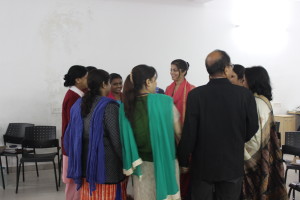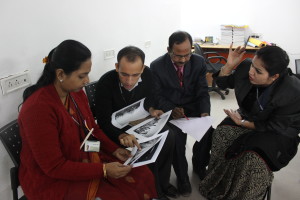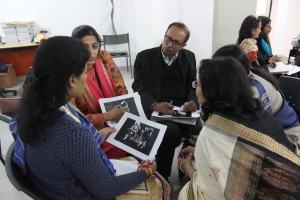‘Rights are something we are born with. But not something we should take for granted.’
As a part of the introductions, we asked each of the twenty-six teachers participating in human rights workshop to share what the word ‘rights’ meant to them. Most agreed that rights come with responsibility.
We then moved on to an activity on social exclusion. Similar to the one played with the peer guides during the training, this one involved the participants in the groups having to make derogatory or rude sounds at the ‘outcasts’ trying to get into their group.
It isn’t easy to yell at a colleague, but some of the teachers really sunk their teeth into it! During the discussion after the activity, teachers mentioned instances when they have seen social exclusion in their classroom—shabbily dressed children, those who aren’t ‘hygienic’ enough are often excluded—others don’t want to sit next to them. Those who aren’t able to keep up academically in class are excluded.
Teachers then shared instances of exclusion they have seen in their personal spheres.
‘ Girls are discriminated against.’
‘ I have seen discrimination in the village I grew up in. The people who belonged to lower castes were not allowed to take part in festivities.’
‘ I have seen young people being treated badly by older people.’
‘ I have been discriminated against because of my religion. I have almost become used to it now.’
The PeaceWorks Human Rights Defenders module was developed as part of the ‘Anne Frank—A History for Today’ project. A resource for teachers to engage high school students in the study of human rights—it uses film, art, literature and poetry—encouraging the students to become human rights defenders. The participants in the workshop were then introduced to the module through a power point presentation.
We moved onto an activity based on Kathryn Cooks ‘ Memory Denied: Turkey and the Armenian Genocide in the classroom’ project. Participants were divided into groups, each group was then given four of Cook’s photographs to analyse.
Following a break for tea, the participants presented what they had discussed. Each group used interesting ways of presenting the photographs they had. Some developed stories linking the pictures. Some developed back-stories for the people shown in the photographs.
We moved onto a small discussion on the importance of using photographs in classrooms. The teachers agreed that this was a useful method of teaching. One of the participants suggested that photographs could be shown to students without giving them a background of the history. Doing some ‘detective’ work about the background of the photograph could form a part of the analysis.
The workshop was short, but what really struck me were the instances the teachers shared about exclusion and the similarities in these instances. I myself have seen a case where children have not wanted to sit next to a classmate shabbily dressed. This was in Calcutta. The teacher who shared this instance during the workshop was in Patna.
Granted, these are cases in two states that share a border, but I am sure that social exclusion at this level occurs everywhere and would be similar in nature even in a continent separated from us by an ocean.
Which makes it even more important to address. To tackle. To take the conversation into our classrooms.
–Paroma Sengupta



